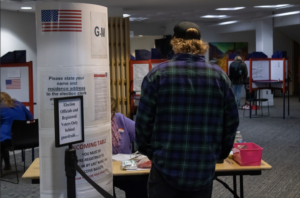Perhaps you have heard the claim that journalism is dying. If not, you have at least heard the claim that mainstream media in the U.S. has been overrun by “corruption” and “fake news” organizations. Both of these claims are false. Journalism isn’t dying, but it is changing from the traditional stacks of printed black and white pages, to twitter posts and online, shareable stories. These alterations change the way we are presented with news and have prioritized speed over content with unintended consequences.
The most recent example of this unfolded in the confusing narrative of what really happened on Jan. 18, at the anti-abortion March for Life rally, on the steps of the Lincoln Memorial. A viral video, originally posted on Instagram but turned viral on Twitter, depicted a group of white, Catholic, teenagers from Covington Catholic School in Kentucky, face-to-face with Nathan Phillips, a 65-year-old Omaha Tribe elder. In the video, Phillips is shown singing and hitting a native drum, while a group of dozens of teenagers is surrounding him, chanting, dancing, or laughing. Most notably, one teenager, Nick Sandmann, is shown inches from Phillips’ face, locking eye-contact with a smile on his face as Phillips continues to sing. With the help of online commentary, this video exploded and created the narrative of a racist and disrespectful confrontation that called upon the Covington School and its community to condemn the actions of their students.
As the video spread, news sources raced to post explanations. Here is where the confusion began.
The way that news exists in today’s society has changed. Consumers of news that prefer reading over watching their news have switched their preferences from print to online sources. According to a study published by the Pew Research Center, compared to print, twice as many adults get their news from online sources, such as news sites or social media.
When the type of news that consumers want changes, the methods of producing and aggregating news changes with it. Social media has quickly become the home base for breaking news stories. Millions of people log in every day to see what is happening around the world, and what they see sparks Google searches of questions that might arise. This is where news organizations want to be; first in line to provide answers. Online news demands immediacy, with every organization racing against the clock, and each other, to be the first to break the story. Here, content can be sacrificed in the name of speed.
In the defense of news, journalists write what they know when they know it. Writing a story is a process, where the collection of information from all sides takes time and effort that can stall the news machines. The “internet outrage machine” as CNN dubbed it, sent the Lincoln Memorial video into swift viral action, with media influencers, celebs and journalists retweeting and adding commentary. As the video gained attention, the news published what they knew at the time: assumptions pulled from the two minute clip and the one sided account of Nathan Phillips, who was still on the scene. The stories posted at this time did not contain the entire fleshed out story, and because of this, narratives were created through critical online commentary created by individuals attempting to connect the dots themselves.
As the story moved forward, the end result became less about what happened and more about taking sides. The country seemed to split between choosing to defend the teenagers or choosing to support Phillips.
In this instance, the original stories misrepresented what happened in the moments before and during the minutes captured on video. As new videos emerged, and more time was taken to commit to diligent reporting, more sides to the stories also surfaced. For instance, later accounts showed that there was a third group of Black Hebrew Israelites who had been shouting with the group of teenagers. Then, Phillips stepped between and approached the group of teenagers himself.
Later statements released by Sandmann state that he did not engage in any provocation with Phillips and that the death threats and insults he had been receiving were based on assumptions made from corrupt portrayals of the event. Further, the claims that Phillips made of hearing chants of “build that wall” have yet to be supported, but have been disputed by Sandmann in his statement. Despite the numerous videos capturing the event, the true intentions of all parties involved are still based, at least partly, on speculation. As time passes, the narrative becomes more convoluted, but those who have taken sides remain firmly in their own beliefs. This serves as the most recent example of how consumers are using news less to learn about the happenings of the world and instead using the news to support their own political arguments.
Many organizations, journalists and celebrities have issued statements apologizing for their hasty conclusions. Because of this, so-called “opponents” of mainstream media, such as Fox News, who is in support of the “fake-news” label for organizations such as the Washington Post, New York Times and CNN, have jumped at the chance to attack and villainize the press. While these organizations did make mistakes, they updated their stories as time went by and included all sides. Further, instead of condemning the organizations that work to keep us informed, we should look inwards at the way we choose to consume and think about news. Journalists and organizations work to provide our country with the best version of the truth they can report from reputable sources and factual reporting — and it is our job as consumers to critically analyze the information they place in front of us and make conclusions for ourselves by engaging in all sides of the story, instead of accepting the first story we see that supports are our already ingrained beliefs.
In the instance of the Lincoln Memorial confrontation video, the media started down the wrong path, criticizing the group of teenagers for being racist and disrespectful. Perhaps, during this period of blaming the media for getting the narrative wrong, we should reflect on why this path seemed to be the most obvious option for many of those who viewed it and the organizations that wrote about it. Our nation has become so desensitized to hatred that we have come to expect racism to be the motivator and default explanations to situations such as these.
Moving forward, let’s focus on why we so easily accept these narratives and work towards challenging those expectations by challenging the standard of racism and hatred that are prevalent here. Let’s also remember that news organizations are here as a service to us. They find and tell the stories of what is happening around us so that we can make informed decisions in our everyday lives that change the way we shape the country.








